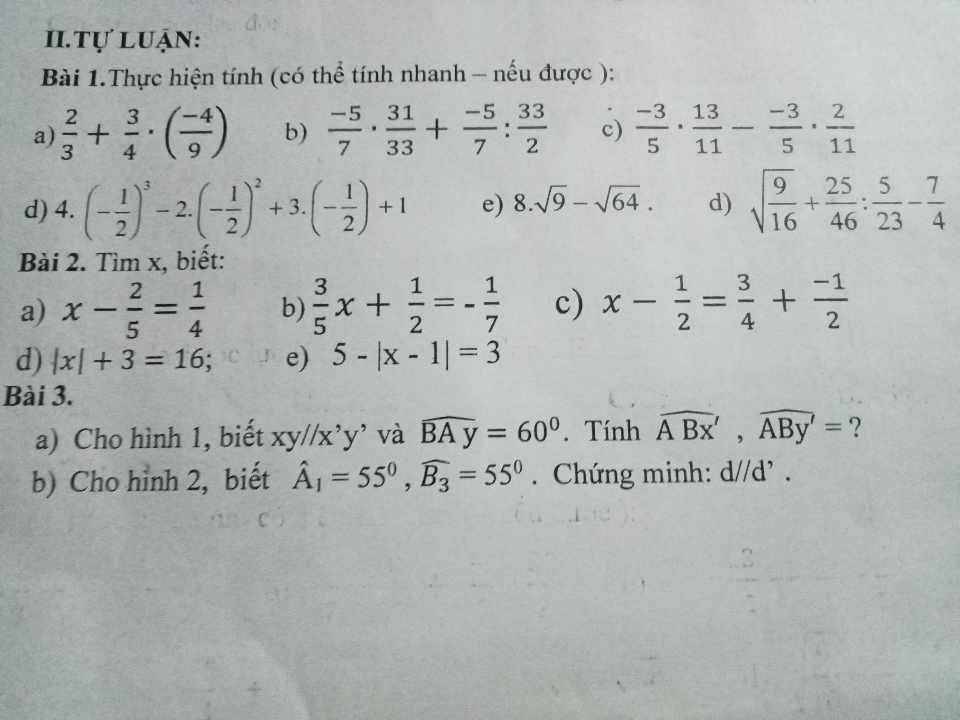Cho a, b, c là ba số khác 0 thỏa mãn: ab/a+b=bc/b+c=ca/c+a ( với giả thiết các tỉ số đều có nghĩa) và a+b=c=1 tính giá trị của biểu thức A=abc(a2+b2+c2)/ab+bc+ca
Hãy nhập câu hỏi của bạn vào đây, nếu là tài khoản VIP, bạn sẽ được ưu tiên trả lời.


\(A=1^3+2^3+3^3+...+n^3\)
Ta chứng minh
\(A=1^3+2^3+3^3+...+n^3=\left(1+2+3+...+n\right)^2\) (1)
+ Với \(n=3\)
\(1^3+2^3+3^3=36\)
\(\left(1+2+3\right)^2=36\)
=> (1) đúng
+ Giả sử (1) đúng với \(n=k\)
\(\Rightarrow1^3+2^3+3^3+...+k^3=\left(1+2+3+...+k\right)^2\)
+ Ta cần chứng minh (1) đúng với \(n=k+1\) Khi đó
\(VT=1^3+2^3+3^3+...+k^3+\left(k+1\right)^3=\)
\(=\left(1+2+3+...+k\right)^2+\left(k+1\right)^3=\)
\(=\left[\dfrac{k\left(k+1\right)}{2}\right]^2+\left(k+1\right)^3=\)
\(=\dfrac{k^2\left(k+1\right)^2+4\left(k+1\right)^3}{4}=\dfrac{\left(k+1\right)^2\left(k^2+4k+4\right)}{4}\)
\(VP=\left[1+2+3+...+k+\left(k+1\right)\right]^2=\)
\(=\left[\dfrac{\left(k+1\right)\left(k+1+1\right)}{2}\right]^2=\)
\(\dfrac{\left(k+1\right)^2\left(k+2\right)^2}{4}=\dfrac{\left(k+1\right)^2\left(k^2+4k+4\right)}{4}\)
Như vậy VT=VP nên (1) đúng với \(n=k+1\)
Theo nguyên tắc của phương pháp quy nạp => (1) đúng

Lời giải:
Gọi số máy cày của 3 đội lần lượt là $a,b,c$.
Vì số máy cày tỉ lệ nghịch với thời gian cày nên:
$4a=6b=8c$; $a-b=1$
Áp dụng TCDTSBN:
$4a=6b=8c=\frac{a}{\frac{1}{4}}=\frac{b}{\frac{1}{6}}=\frac{a-b}{\frac{1}{4}-\frac{1}{6}}=\frac{1}{\frac{1}{12}}=12$
$\Rightarrow a=12:4=3; b=12:6=2; c=12:8=1,5$ máy
Bạn xem lại chứ số máy cày phải là số tự nhiên.

Chiều rộng: 28:(2+5)x2=8 m
Chiều dài: 28-8=20 m
Diện tích: 20x8=160 m vuông

Lời giải:
Cho $b=a+4$ ta có:
$ab+4=a(a+4)+4=a^2+4a+4=(a+2)^2$ là số chính phương.
Vậy với mọi số tự nhiên $a$, tồn tại số tự nhiên $b=a+4$ để $ab+4$ luôn là số chính phương.

Các phần tử của B là: (100 - 1) : 1 + 1 = 100(số)
Tổng của B là: (100 + 1) x 100 : 2 = 5050
Vậy B = 5050

Bạn có thể tham khảo lời giải ở đây nhé:
https://diendantoanhoc.org/topic/81694-t%C3%ADnh-t%E1%BB%95ng-s-13-23-33-n3/

Hello My name is........in class.......from (trường của bạn) .Students join different community activities for a myriad of compelling reasons that transcend mere extracurricular involvement. Firstly, engagement in community activities fosters a sense of belonging and camaraderie among students, providing them with an opportunity to connect with peers who share similar interests or passions. This sense of community often bolsters their self-esteem and social skills, equipping them with invaluable interpersonal abilities that extend beyond the classroom. Additionally, participating in such activities enables students to cultivate a deeper understanding of societal issues and challenges, encouraging empathy and a desire for positive change. Many students also recognize the practical benefits, as community involvement can enhance their resumes, demonstrating to future employers or academic institutions their commitment, leadership qualities, and ability to collaborate effectively within diverse settings. Furthermore, community activities often offer students a platform to explore new hobbies or passions, whether it's volunteering, arts, sports, or advocacy work, allowing them to discover their strengths and interests outside of academic confines. Ultimately, by immersing themselves in various community endeavors, students not only enrich their personal development but also contribute meaningfully to the broader society, shaping them into responsible, empathetic, and well-rounded individuals.


\(\dfrac{ab}{a+b}=\dfrac{bc}{b+c}=\dfrac{ca}{c+a}\)
\(\Rightarrow\dfrac{1}{a}+\dfrac{1}{b}=\dfrac{1}{b}+\dfrac{1}{c}=\dfrac{1}{c}+\dfrac{1}{a}\)
\(\Rightarrow\dfrac{1}{a}=\dfrac{1}{b}=\dfrac{1}{c}=\dfrac{1+1+1}{a+b+c}=\dfrac{3}{a+b+c}=\dfrac{3}{1}=3\)
\(\Rightarrow a=b=c=\dfrac{1}{3}\)
\(\Rightarrow A=\dfrac{a^3\left(a^2+b^2+c^2\right)}{a^2+b^2+c^2}=a^3=\left(\dfrac{1}{3}\right)^3=\dfrac{1}{27}\)